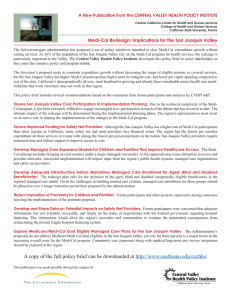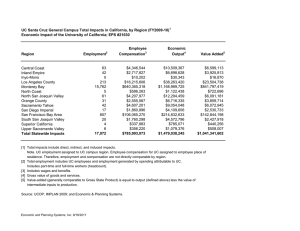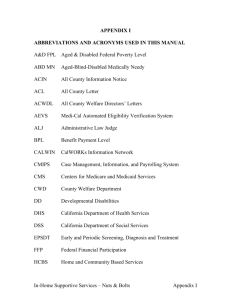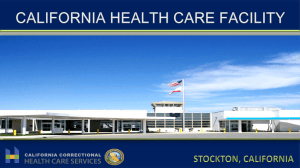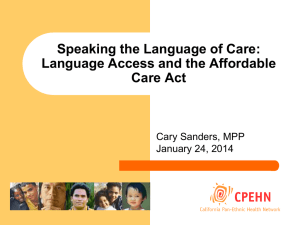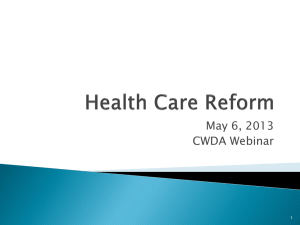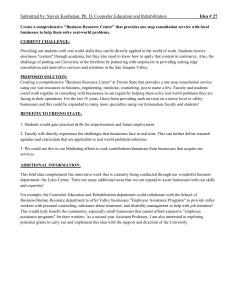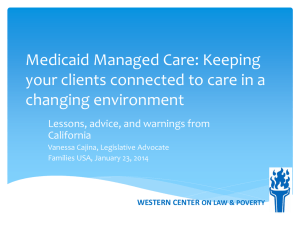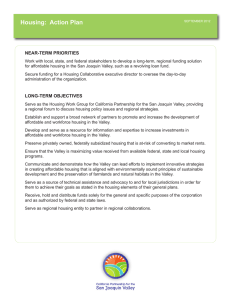Policy Brief June 2005 Medi-Cal Redesign: Implications for the San Joaquin Valley
advertisement
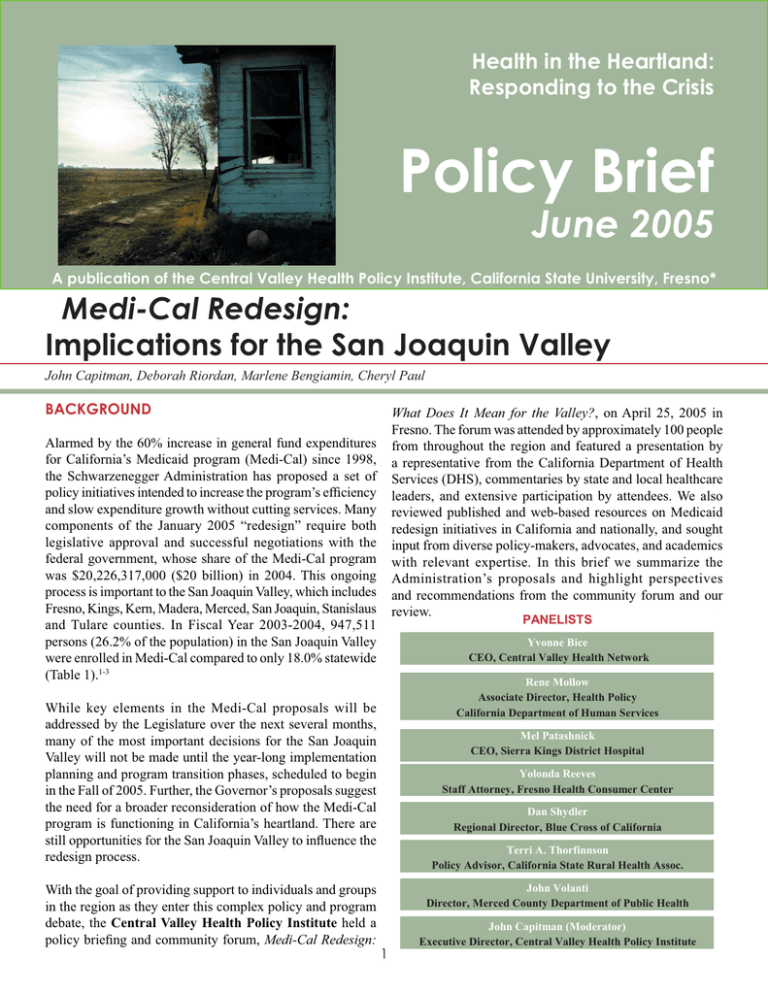
Health in the Heartland: Responding to the Crisis Policy Brief June 2005 A publication of the Central Valley Health Policy Institute, California State University, Fresno* Medi-Cal Redesign: Implications for the San Joaquin Valley John Capitman, Deborah Riordan, Marlene Bengiamin, Cheryl Paul BACKGROUND What Does It Mean for the Valley?, on April 25, 2005 in Fresno. The forum was attended by approximately 100 people from throughout the region and featured a presentation by a representative from the California Department of Health Services (DHS), commentaries by state and local healthcare leaders, and extensive participation by attendees. We also reviewed published and web-based resources on Medicaid redesign initiatives in California and nationally, and sought input from diverse policy-makers, advocates, and academics with relevant expertise. In this brief we summarize the Administration’s proposals and highlight perspectives and recommendations from the community forum and our review. Alarmed by the 60% increase in general fund expenditures for California’s Medicaid program (Medi-Cal) since 1998, the Schwarzenegger Administration has proposed a set of policy initiatives intended to increase the program’s efficiency and slow expenditure growth without cutting services. Many components of the January 2005 “redesign” require both legislative approval and successful negotiations with the federal government, whose share of the Medi-Cal program was $20,226,317,000 ($20 billion) in 2004. This ongoing process is important to the San Joaquin Valley, which includes Fresno, Kings, Kern, Madera, Merced, San Joaquin, Stanislaus and Tulare counties. In Fiscal Year 2003-2004, 947,511 persons (26.2% of the population) in the San Joaquin Valley were enrolled in Medi-Cal compared to only 18.0% statewide (Table 1).1-3 PANELISTS Yvonne Bice CEO, Central Valley Health Network Rene Mollow Associate Director, Health Policy California Department of Human Services While key elements in the Medi-Cal proposals will be addressed by the Legislature over the next several months, many of the most important decisions for the San Joaquin Valley will not be made until the year-long implementation planning and program transition phases, scheduled to begin in the Fall of 2005. Further, the Governor’s proposals suggest the need for a broader reconsideration of how the Medi-Cal program is functioning in California’s heartland. There are still opportunities for the San Joaquin Valley to influence the redesign process. Mel Patashnick CEO, Sierra Kings District Hospital Yolonda Reeves Staff Attorney, Fresno Health Consumer Center Dan Shydler Regional Director, Blue Cross of California Terri A. Thorfinnson Policy Advisor, California State Rural Health Assoc. John Volanti Director, Merced County Department of Public Health With the goal of providing support to individuals and groups in the region as they enter this complex policy and program debate, the Central Valley Health Policy Institute held a policy briefing and community forum, Medi-Cal Redesign: John Capitman (Moderator) Executive Director, Central Valley Health Policy Institute 1 REDESIGN GOALS AND THE SAN JOAQUIN VALLEY The Administration emphasizes the dramatic growth in MediCal beneficiaries and expenditures as the primary reason for Medi-Cal program changes. While general fund expenditures for Medi-Cal have grown by $4.5 billion since 1998, this growth is attributed to demographic trends (such as growth in low-income and other populations without adequate insurance and growth in the aged, blind and disabled populations), increasing health care costs, and program expansions that have added new groups of beneficiaries. In this context, the Governor’s proposal seeks to constrain expenditure growth without decreasing the range of eligible persons or covered services.4 The San Joaquin Valley experiences poverty rates that are among the highest in the nation. The average per capita income in the San Joaquin Valley in 2002 was lower than the per capita income in any of the 50 states and 34% lower than California’s per capita income ($21,738 in the San Joaquin Valley compared to California’s $32,845).6-8 Were the San Joaquin Valley counties to be considered separately from the rest of the state, they would be eligible for a higher level of Federal matching funds (Federal Medical Assistance Percentage or FMAP) for Medicaid than California as a whole. The demographic profile of the San Joaquin Valley differs from the rest of the state in other ways that indicate more complex health care needs. The region has a rapidly growing population and greater racial/ethnic diversity than other parts of California. It also has among the highest rates of uninsured persons in the state.9 However, the per capita spending for Medi-Cal eligibles in the eight San Joaquin Valley counties is up to 50% less than the average per capita spending statewide (Table 1).1-3 Given higher Medi-Cal participation, higher need for indigent care, and lower per capita spending compared to other California regions, a Medi-Cal redesign strategy that emphasizes little or no growth in overall program expenditures may raise unique concerns in the San Joaquin Valley both for medically underserved residents and already struggling safety net providers. Forum participants generally lauded the Administration for preserving the scope of Medi-Cal benefits and eligibility. They noted, however, that increasing Medi-Cal costs in California were part of a national trend. California is not among the most generous states in terms of program inclusion (the proportion of the population eligible for the program) or expenditures per enrollee. In comparison to other states, California ranked 28th in average growth in monthly Medicaid enrollment from June 2002-20035, 34th in the percentage change in growth from 1997 to 2003, and 29th in the percentage of the general fund monies expended on Medicaid for 2003. The percentage of low income Californians (<200% of the federal poverty level) enrolled in Medicaid was 34% for 2002-2003 with 24 states reporting a larger percentage of their low income population enrolled in Medicaid. 6 Table 1 Medi-Cal Program Characteristics and the San Joaquin Valley: Persons Enrolled in Relation to Poverty and Medi-Cal Spending County # Enrolled in Medi-Cal Cost per Enrollee w/ DSH 2001 Cost per Enrollee w/o DSH 2001 Managed Care # of Enrollees per 100 Population (2003-04) % Below FPL (1999/2003) d Fresno 255,416 $2,564.84 $2,368.18 Yes 29.6 22.9/21.8 Kern 183,416 $2,609.24 $2,434.73 Yes 25.5 20.8/18.1 e Kings 29,148 $2,653.04 $2,546.16 No 20.6 19.5/NA f Madera 34,733 $3,001.53 $2,616.80 No 25.7 21.4/NA f Merced 69,965 $1,982.71 $1,957.00 No 30.1 21.7/NA f San Joaquin 133,941 $2,922.42 $2,826.66 Yes 21.2 17.7/14.2 b Stanislaus 111,627 $2,669.85 $2,584.01 Yes 22.7 16.0/12.9 c Tulare 129,265 $3,344.49 $3,339.97 Yes 32.6 23.9/22.9 a 6,514,384 $3,990.94 $3,809.00 Yes 18.0 14.2/13.4 California a d b Ranked #5 for US counties** for highest percentage below FPL Ranked #57 for US counties** for highest percentage below FPL c Ranked #81 for US counties** for highest percentage below FPL e **Based on a survey of 233 counties throughout the United States 2 Ranked #7 for US counties** for highest percentage below FPL Ranked #20 for US counties** for highest percentage below FPL f If included in ranking, would be in the top 25** THE GOVERNOR’S PROPOSALS capitated, comprehensive, case managed health care delivery system. COHS is available in eight counties in California, primarily in the Bay Area and Central Coast. Enrollment is mandatory for all Medi-Cal members including Medicare/ Medi-Cal dual eligibles. Essentially, FFS is not offered in these counties with a few minor exceptions. The COHS model requires a federal waiver per Section 704 of the Medicare, Medicaid and SCHIP Benefits Improvement and Protection Act of 2000 and is limited to 14% of Medi-Cal enrollees. Additionally, since it provides services to higher cost MediCal eligibles, the COHS capitation rate is higher than other MC plans. COHS capitation rates are not made public. The Administration’s redesign proposal includes multiple components. Most notable among these for the San Joaquin Valley are the expansion of managed care delivery systems, hospital financing changes and beneficiary cost sharing. Other elements of the proposal were not discussed in detail at the community forum. Delivery Systems Currently, Medi-Cal has two delivery systems, fee-forservice (FFS) and managed-cared (MC). They each serve approximately 50% of Medi-Cal beneficiaries statewide. Most (91%) of MC participants are low income children and adults. These individuals have lower annual costs of care than other Medi-Cal eligible populations. By contrast, only 18% of the other Medi-Cal enrolled populations participate in MC. Although less numerous, these other groups (such as elders, persons with disabilities, and certain emergency care patients) have higher costs of care because of complex medical and chronic care needs. In 2000, aged, blind and disabled participants accounted for 67% of total program costs. Although frail, low-income elders account for 30% of total Medi-Cal expenditures, these Medicare/Medi-Cal dual eligibles tend not to be enrolled in MC. 10 The Medi-Cal redesign proposes to expand MC systems from 22 to 35 counties beginning in January 2007. Enrollees will be transitioned into MC programs through mandatory enrollment of new enrollees and transitioning FFS enrollees, as appropriate, at their next eligibility redetermination.4 In general, under the proposal, 13 additional counties will have mandatory enrollment of families and children into MC plans. Seniors and persons will disabilities (except Medicare/ Medi-Cal dual eligibles) will have mandatory enrollment in MC plans in 27 counties. Additionally, Medicare/Medi-Cal dual eligibles will be enrolled in Acute and Long-Term Care Integration Projects in Contra Costa, Orange and San Diego counties.This expansion of managed Medi-Cal requires a federal waiver that demonstrates cost effectiveness. 11 All 58 California counties have FFS options to varying degrees. Three different models of MC are now offered in 22 counties. The Two-Plan model of MC is available in 12 counties including the Valley counties of Fresno, Kern, San Joaquin and Tulare. In these counties, the DHS contracts with two MC plans, a locally developed health care service plan (Local Initiative) and a commercial plan that is selected by a competitive process. Fresno and Tulare counties each have two commercial plans available for beneficiaries. Families and children are required to enroll in MC in Two-Plan counties while seniors and persons with disabilities have the option of selecting a FFS or MC delivery system. Medicare/Medi-Cal dual eligibles are not eligible for MC enrollment. In the Two Plan counties of the San Joaquin Valley, the addition of aged, blind and disabled Medi-Cal members (who are not dual eligibles) would increase MC enrollment by 16,211 in Fresno; 12,838 in Kern; 13,007 in San Joaquin; 9,612 in Stanislaus; and 7,168 in Tulare.12 In the current FFS counties of the San Joaquin Valley, MC enrollment would increase by approximately 60,820 in Merced; 25,239 in Kings; and 31,116 in Madera.13 Geographic Managed Care for the San Joaquin Valley The Geographic Managed Care (GMC) model offers beneficiaries a choice of multiple managed care plans that have contracted with DHS in a non-competitive process. Only San Diego and Sacramento counties currently offer this model. Like the Two-Plan model, families and children are required to enroll in a MC plan while other Medi-Cal members have the choice of FFS or MC. Medicare/Medi-Cal dual eligibles are not eligible for MC enrollment. Currently Fresno, Tulare, Kern, San Joaquin and Stanislaus counties have implemented the Two Plan Managed Care model. Madera, Merced and Kings Counties offer only the FFS delivery system. Under the redesign proposal, Fresno, Madera, Merced and, possibly, Kings counties would become GMC counties while the remaining counties would continue with the Two-Plan model. As a result, all families, children, aged, blind and disabled persons (excluding dual eligibles) in the San Joaquin Valley would be mandatory enrollees in MC (Figure 1). The final model is the County Organized Health Systems (COHS) model. With this model a county or county group creates a local agency that contracts with DHS to provide a 3 Figure 1 Distribution of Existing and Proposed Managed Care Counties in the San Joaquin Valley, 2005 The GMC model requires that all Medi-Cal participants select a managed care plan. Based on the experiences in San Diego and Sacramento, 5-10 MC organizations might compete for Medi-Cal members and be assigned, on a rotating basis, members who do not select a plan. Forum participants pointed to three sets of concerns with this proposal: new access barriers, new burdens on providers, and less consumer choice. New Burdens on Providers: The GMC expansion strategy may force local safety net providers to participate in multiple managed care organizations, creating new burdens on providers and additional access barriers for beneficiaries. Less Consumer Choice: One goal of the GMC expansion is to create more health plan choices for Medi-Cal beneficiaries. Forum participants were concerned that rather than benefiting from new choices, participants find themselves bewildered or unable to discern meaningful differences among the options. Participants also worried that competing MC plans serving the region might engage in aggressive marketing efforts that would further exacerbate confusion among beneficiaries. As a result, more beneficiaries may fail to select a plan and be assigned by administrators to a health plan that may or may not meet their needs. With increased administrative assignment to MC plans, beneficiaries would lose rather than gain opportunities for a meaningful choice of plans. New Access Barriers: With respect to utilization, the GMC model might force new patterns of travel for health care that impose unreasonable access barriers. Participants proposed that a more appropriate managed care design for the San Joaquin Valley would be to expand the Fresno and Tulare Counties Two-Plan model to both Kings and Madera counties. According to forum participants, enrollees in Merced County, where Medi-Cal and other patients are considered more likely to receive primary, acute and specialty care from practitioners based in Stanislaus and San Joaquin counties, would be better served by participating in a regional plan with those counties. 4 Forum participants also voiced more general concerns regarding the appropriateness of a managed care model for rural areas. Northern California counties have already had managed care plans pull out due to inadequate numbers of enrollees and providers. In a recent survey of rural health providers across the state, Fresno County was the only rural county in support of managed care, reflecting positive experiences. Respondents from other counties were concerned that low reimbursement rates and competing MC organizations tended to exacerbate problems associated with already inadequate supplies of professionals and providers.14 Forum participants worried that planning for the transition, developing the provider panels, and building the patterns of case collaboration needed to avoid institutional and hospital placements for frail Medi-Cal members were not adequately addressed in the current plans. Careful, incremental expansion of current managed care plans in Fresno and Tulare counties, in close consultation with existing delivery systems to accommodate these new populations, might achieve greater managed care enrollment with less upheaval for patients and providers. Safety Net Hospital Financing Several participants noted that many of the region’s residents who are involved in agriculture, seasonal employment, and rapid-change industries, such as construction, frequently move between counties. The possibility of a Central Valley Rural Model, a collaboration between counties to simplify eligibility determination and support continuity of enrollment and care, was proposed to address the mobility of rural low-income families in the region. Mandatory Managed Care for the Aged, Blind and Disabled Statewide and in the San Joaquin Valley most aged, blind and disabled Medi-Cal participants are also enrolled in Medicare. Nonetheless, as shown in Table 2, about 70,000 aged, blind, disabled, or long-term care Medi-Cal beneficiaries in the San Joaquin Valley will become mandatory managed care enrollees under the Administration’s proposals.12 Forum speakers noted how difficult it may be to transition these individuals to MC. Of this group of beneficiaries, some 74% are eligible for Medi-Cal because they are SSI/SSP participants. Because of their complex health situations, co-morbid physical, mental and other disabilities, and complex social/behavioral status, effective service to these beneficiaries requires a specialized system of referral and case-sharing protocols with a range of provider types. Like most other states, California has crafted a complex set of financing mechanisms for the sub-set of hospitals that provide Medicaid-reimbursed and uncompensated care. In some cases these agreements are based on waivers of federal Medicaid rules. California’s current Selective Provider Contracting Program waiver expires June 30, 2005 and a new hospital financing waiver in the form of a 1115 Demonstration Waiver is being negotiated. The Administration is proposing combining funds from several sources in a safety net pool, recalculating maximum payments, and other changes in response to new federal priorities. As in other states, California’s hospitals depend on federal funding to maintain their solvency. Currently, California hospitals receive a little over $2 billion in federal funding, half of which comes from Disproportionate Share Hospitals (DSH) monies. Hospitals qualifying for DSH are determined by the state as serving a large number of Medicaid and low-income uninsured patients based on federal minimum standards. There are two limits in determining the amount of DSH payments a state can make to a DSH hospital. First, the total amount of federal funds a state can spend on total DSH hospital allotments is fixed Table 2 Aged Blind and Disabled (ABD) and Long Term Care (LTC) Medical Enrollees by County County # of Enrollees Fresno Kern Kings Madera Merced San Joaquin Stanislaus Tulare 16,211 12,838 2,421 2,241 5,945 13,007 9,612 7,168 Total 69,443 5 Percent of Total California ABD & LTC Enrollees 3.2% 2.6% 0.5% 0.4% 1.2% 2.6% 1.9% 1.4% 13.8% Table 3 Total DSH Payments and DSH as a Percentage of Total Medi-Cal Expenditures by County and California, Fiscal Year 2001/02 Fresno Kern Kings Madera Merced San Joaquin Stanislaus Tulare DSH as a % of Total Medi-Cal Expenditures FY 2001/02 7.7% 6.7% 4.0% 12.8% 1.3% 3.3% 3.2% 14.0% Central Valley Region California 4.8% 4.6% in federal statute. Second, within each state, the total amount of Medicaid DSH payments made to an individual hospital can not exceed 100% of the hospital’s uncompensated costs for Medicaid and uninsured patients. California received a permanent increase in this limit to 175% in 2000. Table 3 provides an overview of DSH funding in the San Joaquin Valley.2 Total DSH Expenditures FY 2001/02 (Less Transfers) $45,200,544 $26,504,164 $2,651,745 $10,703,597 $1,570,005 $10,178,475 $7,994,543 $498,090 $105,904,163 $1,017,285,568 by 100.4% or 3.5 % per year compared to non-contracting hospitals whose rates have increased by 277.5% or 6.9% per year. Over 90 % of Medi-Cal inpatient days were provided by SPCP hospitals. This federal waiver is set to expire on June 30, 2005. The Administration is currently in negotiations with CMS to obtain a 1115 Demonstration Waiver to stabilize federal funding of hospitals over a five year period. The state legislature may have little choice but to accept the results of these negotiations given the significant proportion of total hospital funding that is at stake. Components of the Administration’s proposal are as follows: California also uses intergovernmental transfers (IGTs) as a legitimate method to pay its share of the spending to draw down federal DSH payments. This transfer of money from one governmental entity to another, by law, must involve only federally permissible public monies. Additionally, current federal law specifies that no more than 60% of a state’s share of Medicaid spending may come from local funds. There has been much controversy surrounding the use of IGTs as the federal Centers for Medicare and Medicaid Services (CMS) attempts to hold states accountable for the actual amount spent for Medicaid services. Many states have used “creative financing” through provider taxes, donations and use of the Upper Payment Limit (UPL) to claim federal matching funds in excess of actual expenditures. 15 1. Retain elements of the Selective Provider Contracting Program. 2. Replace IGT with Certified Public Expenditures (CPEs) for the 21 largest public hospitals and the University of California hospitals. CPEs are a financing mechanism acceptable to the federal government and already used by several programs within Medi-Cal. CPE hospitals would “certify” their expenditure of public funds for indigent and Medi-Cal patients. The state plans to negotiate more reasonable cost categories that reflect actual hospital costs with the CMS (outcome unknown). The other “big” unknown is whether the CMS will allow California to include expenditures for indigent health in the CPE cost methodology. The Selective Provider Contracting Program (SPCP), allows California to competitively negotiate a per diem rate for all inpatient services with certain hospitals (primarily urban). This program has allowed the state to ensure hospital beds for the Medi-Cal population as well as decreasing state costs. From the years 1984-2003 SPCP hospital rates have increased 6 additional federal funds. The potential impact on large private hospitals such as Community Medical Centers in Fresno, one of the largest non-public DSH hospitals in the state, are unclear. 3. Establish a safety net care pool modeled by a recently completed waiver renewal in Massachusetts. 16 Massachusetts uses this “pool” to pay for health care for the uninsured. MassHealth negotiated a budget neutrality trend rate increase over a three year period. In California the safety net care pool would be capped at $766 million for each year of the five year waiver. (This is new information obatined since the forum was held.) The primary intended use of the “pool” funds would be to cover health care services provided in hospitals and through public programs to the uninsured. The pool would consist of funding that was previously available under the SB1255 program (Emergency Services and Supplemental Payments Program), additional funding of $180 millon a year for each of the five years of the waiver (still under negotiation), some funding from the current DSH program (still under negotiation), and federal funding that is mandated to be phased out within the four years. Discussion regarding the Governor’s proposals to stabilize California’s hospital financing generated more questions than answers. Individual stakeholders were confused as to how the redesign would benefit or harm current San Joaquin Valley health interests. The Administration can not specify the mechanism for distribution of funds until they successfully negotiate the terms of the waiver with CMS. In question, specifically, is federal funding for CPEs generated from providing indigent health services and whether IGTs will be allowed on a restricted basis. Forum participants did emphasize the need for timely updates on the progress of negotiations with the CMS. Beneficiary Cost Sharing Currently Medi-Cal beneficiary cost sharing is limited to groups for whom coverage is not mandated by Federal law. In California, cost sharing for “medically needy” and “medically indigent” beneficiaries is based on family monthly income. The re-design proposal calls for extending the imposition of a monthly premium to additional Medi-Cal enrollees with incomes above 100% of the federal poverty level. The premiums would be $4 for children under 21 years and $10 for adults with a family maximum of $27 per month. The premium program would begin January 1, 2007. Individual counties would be responsible for determining premium requirements for enrollees, with the collection of premiums contracted to an outside vendor. Enrollees who fail to pay the premium for two consecutive months, would be removed from the Medi-Cal program. To re-enroll the individual would be required to pay up to six months of back premiums. This proposal will require state legislative approval followed by development of a federal 1115 waiver application prior to December 2005. The non-federal share (state and/or local) of payments in this pool would come from CPEs. Public providers could be reimbursed from the safety net care pool for providing healthcare services to the uninsured. The state will not indicate how the safety net money will be distributed until after the waiver receives federal approval. Massachusetts has been allowed significant flexibility in the distribution of the funds by the CMS.16 4. Currently, supplemental state and federal payments for safety net hospitals (SB1255) to meet uncompensated care costs for indigent patients are negotiated based on the number of Medi-Cal FFS inpatient days billed by the hospital. With increased enrollment in MC, hospitals could lose up to 30% of their current payments. The proposal calls for de-linking supplemental payments to safety net hospitals from their Medi-Cal FFS inpatients days and distributing these supplemental funds through the safety net pool. This approach would limit the effect of managed-care expansion on safety net hospitals. Hospital advocates, however, worry that MC expansions would have the effect of redirecting more Medi-Cal patients to private hospitals and that de-linking of supplemental payments would not address this problem. 5. Forum participants unanimously expressed their concern regarding the monthly premium proposal. All California rural health providers participating in a recent survey stated that enrollees could not afford premiums for health care.14 Additionally, premiums would not generate revenue due to the administrative costs involved in collection and reenrollment. Realistically, it was felt that premiums would only serve to increase the number of uninsured in the San Joaquin Valley, increasing health care costs for the state and jeopardizing the solvency of health care providers. It was estimated that there would be at least a 20% attrition rate in Medi-Cal enrollment in the San Joaquin Valley if premiums were implemented. Private hospitals currently participating in the DSH, those that serve a disproportionate share of Medi-Cal and indigent patients, would “swap” their DSH monies for compensation from the state’s General Fund. The state would add the DSH money to the “safety net pool” where it could be used to pay the non-federal share (state and/or local) of public hospital CPEs and to draw down 7 These concerns seem consistent with experiences in other states that have explored the imposition of co-payment requirements. A recent Community Health Councils, Inc. publication reported that imposing premiums has only served to reduce enrollment and health care access. Oregon experienced a 51% reduction in enrollment within the first year of implementing premiums with 60% of disenrollees experiencing an unmet health need. Increased revenue did not materialize while the number of eligible applicants suspended from the program due to unpaid premiums continued to increase. While Oregon did achieve state Medicaid savings due to decreased enrollment they suffered a substantial loss in Federal matching funds.17 CONCLUSIONS AND RECOMMENDATIONS* Based on the comments from forum participants, our reviews of existing materials, and interviews with experts, we offer the following conclusions and recommendations. 1) Ensure San Joaquin Valley Civic Participation In Implementation Planning: Due to the technical complexity of Medi-Cal redesign and the delicacy of multiparty negotiations between the Administration, the federal government and the state legislature, it has been extremely difficult to engage meaningful civic participation in much of the debate that has occurred to date. Even over the next few months, there may be limited opportunities for communities and individuals in the San Joaquin Valley to shape the broad outlines of any re-design effort. The ultimate impact of many Medi-Cal redesign components will be determined during the implementation planning, final rule making, and program transition phases. By insisting on active participation by diverse representatives of the region in these decision-making processes, the communities of the San Joaquin Valley can create opportunities to improve health care for our low-income and indigent residents. The central recommendation from the community forum participants and our analyses is that the region’s representatives and community leaders must insist on taking an active role in shaping the implementation of the changes to the Medi-Cal system. 2) Ensure Improved Funding for Safety Net Providers: Although the San Joaquin Valley has a higher rate of MediCal participation than other regions in California, many safety net and rural providers face financial crises. That the health system for low-income and indigent persons in the Valley is stressed should be no surprise. The region has the lowest per enrollee expenditure on these services in a state with among the lowest per person payments in the nation. San Joaquin Valley providers -- especially district hospitals, rural clinics, community health clinics, and private safety net hospitals -require sustained state and federal support to improve access to care and address health professional shortages. Due to the many unanswered questions about the Administration’s proposal, it is unclear if the goal to increase support for the Medi-Cal system in the Valley will be reached. Many of the most important elements of the redesign for the region, such as the distribution of funds from the proposed safety net pool and quality standards for new MC plans, will only be addressed during implementation planning. Medi-Cal redesign authorizing legislation and implementation planning need to include provisions that ensure improved funding for the San Joaquin Valley safety net providers. There also needs to be ongoing attention to ensure that the region’s communities participate in implementation planning so that program changes address the region’s needs. 8 6) Develop and Share Data on Potential Impacts on Safety Net Providers: Forum participants were concerned that adequate information was not available, accessible, and timely on the status of negotiations with the Federal government regarding hospital financing. They felt it would be helpful to have a best and worse case scenario analyses regarding changes in hospital financing from an independent source. Such data would allow the region’s providers and communities to evaluate the unintended consequences (both short term and long term) from restructuring the present fragile hospital financing system. Decisions on many of the most pressing hospital financing issues for of the San Joaquin Valley have been postponed, resulting in an ongoing need for these analyses. 3) Develop Managed Care Expansion Models for Children and Families That Improve Healthcare Access: The Medi-Cal redesign includes bringing several San Joaquin Valley counties under a single MC model that features multiple competing health plans. Forum participants underscored the plan’s potential for disruption in access, continuity of care, and provider network relationships. Also highlighted were the special concerns with MC approaches among rural providers and the communities they serve. It is crucial for successful implementation of any Medi-Cal redesign to obtain input from county public health systems, managed care organizations and safety net providers to develop an MC expansion plan sensitive to place and population, with the least amount of health care disruption. At the same time, forum participants noted that San Joaquin Valley counties needed improved mechanisms for ensuring continuity of coverage and care for persons whose work requires regular across-county residential moves. Also highlighted were real barriers to care associated with rural conditions and health professional shortages. The Medi-Cal MC re-design must focus on improving health care access. 7) Explore Medicare/Medi-Cal Dual Eligible Managed Care Plans for the San Joaquin Valley: The Administration’s proposals do not address Medicare/ Medi-Cal dual eligibles in the San Joaquin Valley. Forum participants noted that this population is expensive to serve. Care costs for dual eligible enrollees represent a major factor in the increasing overall costs for the Medi-Cal program. The San Joaquin Valley is expected to see a rising elder population and is viewed as under-developed from the perspectives of community alternatives to nursing home placement or mechanisms to integrate primary, acute, and long-term care services. Managed community care expansion along with medical/long-term care service integration should be explored in the region. The Valley would be an ideal demonstration area where models that introduce managed care to the aged, blind, and disabled, both the Medi-Cal only and dual eligible, could be implemented. 4) Develop Adequate Infrastructure before Mandatory Managed Care Enrollment for Aged, Blind and Disabled Beneficiaries: The redesign plan calls for the inclusion of the aged, blind and disabled categorically eligible beneficiaries (but not Medicare/MediCal dual enrollees) in the regional MC model. Forum participants voiced concerns that adequate care for these population groups requires well-developed referral networks and specialized clinical protocols. Collaborative efforts between the state, the San Joaquin Valley counties, and health and supportive service providers to develop an appropriate care management, care coordination, and specialty and supportive services infrastructure for serving medically complex populations should precede mandatory MC enrollment of these groups. Given the challenges in building such infrastructure, MC enrollment for these groups should be phased-in over a longer transition period than proposed by the Administration. The views of San Joaquin Valley community forum participants and our assessment of the Administration’s Medi-Cal redesign proposals provide a strong endorsement for the Administration’s goal of sustaining program eligibility and scope of services. California’s heartland is growing and already faces remarkable unmet health care needs. Its demographic diversity and rural character mean that solutions that work elsewhere in the state may not be so easily applied to this region. With many of the most important decisions on Medi-Cal redesign still to come, the best interests of our communities and residents require ongoing participation in health care program redesign planning and implementation. 5) Reject Imposition of Premiums for Children and Families: Forum participants and other analysts expressed a strong consensus rejecting the implementation of the premium proposal. Most agreed that any gains associated with an increased sense of beneficiary responsibility for health would be offset by increased administrative costs and significant levels of disenrollment from Medi-Cal. Both forum participants and analysts generally believed that if implemented, this proposal would increase the number of uninsured in the region, decrease continuity of care, increase inappropriate use of emergency services, and place new financial burdens on the region’s safety net providers. * This policy brief was supported through a grant from The California Endowment to California State University, Fresno. The views expressed in this report are those of the authors and do not necessarily reflect those of the funders or the University. 9 REFERENCES 1. 2. 3. 4. 5. 6. 7. 8. 9. 10. 11. 12. 13. 14. 15. 16. 17. California Department of Health Services, Medical Care Statistics Section. Medi-Cal beneficiary counts as a percent of population by county for fiscal year 2003-2004. Available at: http://www.dhs.ca.gov/admin/ffdmb/mcss/RequestedData/Population/FY200304%20Eligibles%20as%20a%20Percent%20of%20Population.htm. Retrieved April 26, 2005. California HealthCare Foundation. Medi-Cal County Data. Available at http://www.chcf.org/topics/medi-cal/index. cfm?subsection=county Retrieved April 26, 2005. American Community Survey. Percent of People Below Poverty Level in the Past 12 Months (for whom poverty status is determined). Available at http://www.census.gov/acs/www/Products/Ranking/2003/R01T050.htm. Retrieved April 26, 2005. Belshé SK, Shewry S. Medi-Cal Redesign January 2005. Available at: http://www.dhs.ca.gov/mcs/mcpd/MCReform/PDFs/MC Redesign 1-12-05 final updated.pdf. Retrieved April 18, 2005. Ellis ER, Smith VK, Rousseau DM. Medicaid enrollment in 50 states: June 2003 data update. Kaiser Commission on Medicaid and the Uninsured, October 2004. Available at: www.kff.org. Retrieved April 28, 2005. Kaiser Family Foundation. Statehealthfacts.org. Available at: http://www.statehealthfacts.org/cgi-bin/healthfacts.cgi Retrieved May 5, 2005. California Department of Finance. Table D-9: Per capita personal income by county, California, 1992-2002. Available at: http:// www.dof.ca.gov/html/fs_data/stat-abs/tables/d9.pdf. Retrieved April 28, 2005. Bureau of Economic Analysis. CA1-3: Personal income summary estimates/Per capita personal income for U.S., States, and Regions. http://www.bea.doc.gov/bea/regional/reis/. Retrieved May 5, 2005. Diringer J, Curtis KA, Paul CM, Deveau DR (2004). Health in the Heartland: The Crisis Continues. Fresno, CA. California State University Fresno. Kaiser Commission on Medicaid Facts, Kaiser Family Foundation. The California Medicaid program at a glance, July 2004. Available at: http://www.kff.org/statepolicy/7138.cfm. Retrieved May 5, 2005 Johns Hopkins AIDS Service. Medicaid Overview: Reform and Managed Care, 1997-2004. Available at: http://www.hopkins-aids. edu/manage/medicaid_2.html. Retrieved May, 9, 2005. Medi-Cal Care Statistics Section, California Department of Health Services . 2005 Medi-Cal Managed Care Expansion-Aged, Blind, Disabled and Long Term Care population, Table 3, Pg 6, January 31, 2005. Available at http://www.dhs.ca.gov/mcs/mcpd/MCReform/PDFs/SeniorsanddreportRevised- 1.8.pdf. Retrieved April 28, 2005. Medi-Cal Care Statistics Section, California Department of Health Services. Beneficiary Profiles by County for October 2003. Available at: http://www.dhs.ca.gov/admin/ffdmb/mcss/mcss.htm, Accessed 05/03/05) Thorfinnson TA. California State Rural Health Association Medi-Cal Redesign Health Provider Survey, Draft Report, May 2005. Rousseau D, Schneider A. Current issues in medicaid financing-an overview of IGTs, UPLs, and DSH. Kaiser Commission on Medicaid and the Uninsured, April 2004. Available at: http://www.kff.org/medicaid/7071.cfm. Retrieved May 5, 2005. Massachusetts Medicaid Policy Institute. The MassHealth Waiver: Issue Brief, April 2005. Available at: http://www.massmedicaid. org/briefs.html. Retrieved May 5, 2005. Community Health Councils, Inc. The Myths of California’s Medi-Cal Redesign Goals, July 2004. Available at: http://www.chcinc.org/chcInsidePubs.cfm. Retrieved April 27, 2005. Additional copies of this publication are available at: http://www.csufresno.edu/ccchhs/pubs Central Valley Health Policy Institute Central California Center for Health and Human Services College of Health and Human Services California State University, Fresno 1625 E. Shaw Avenue, Suite 146 Fresno, CA 93710-8106 This publication was made possible through the support of 10
